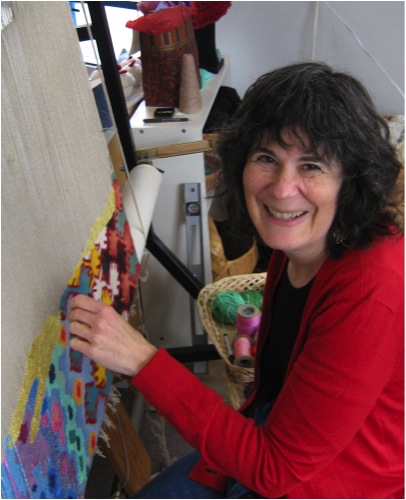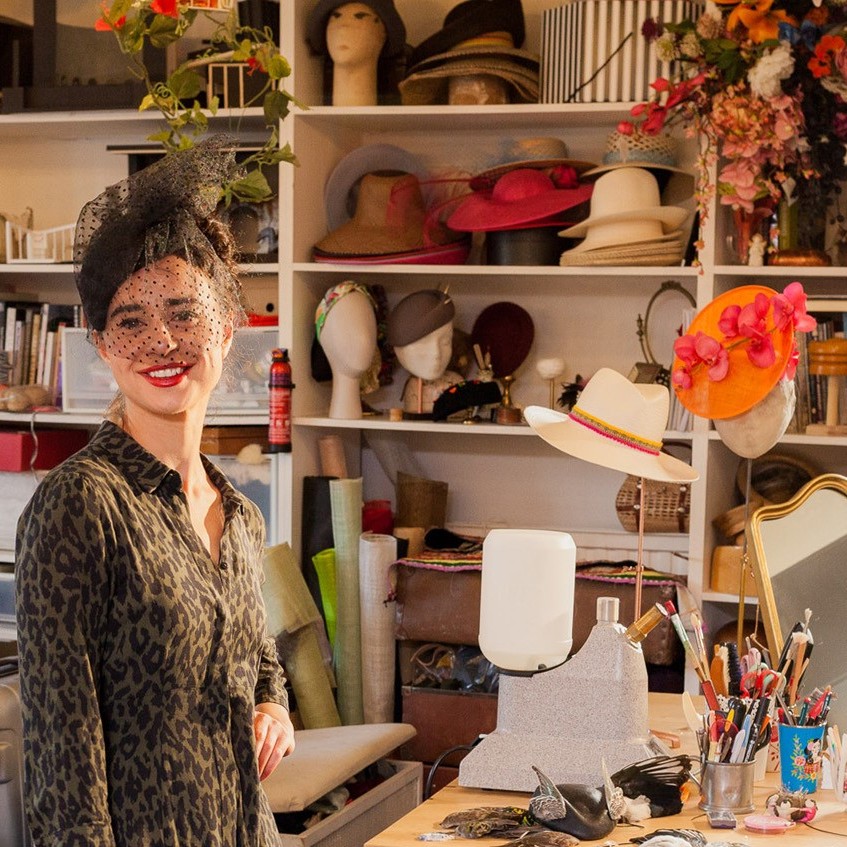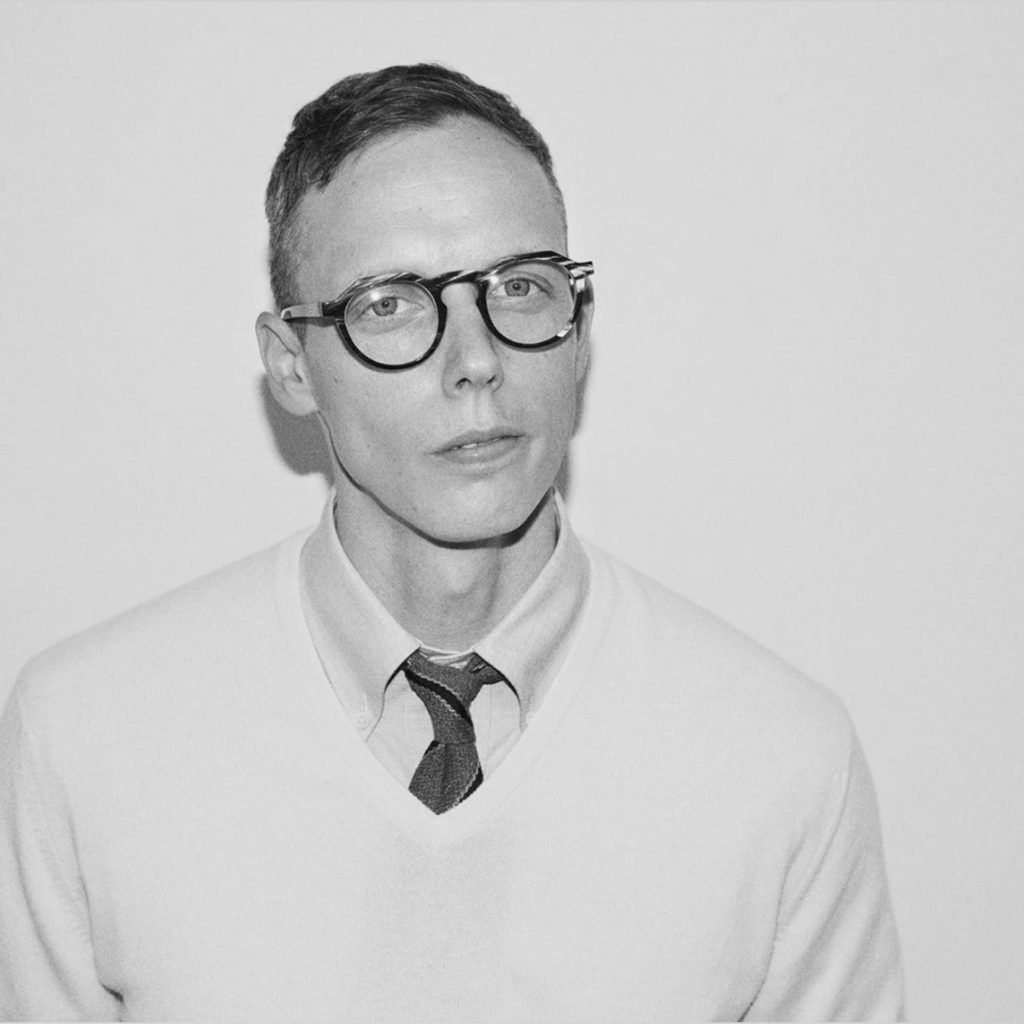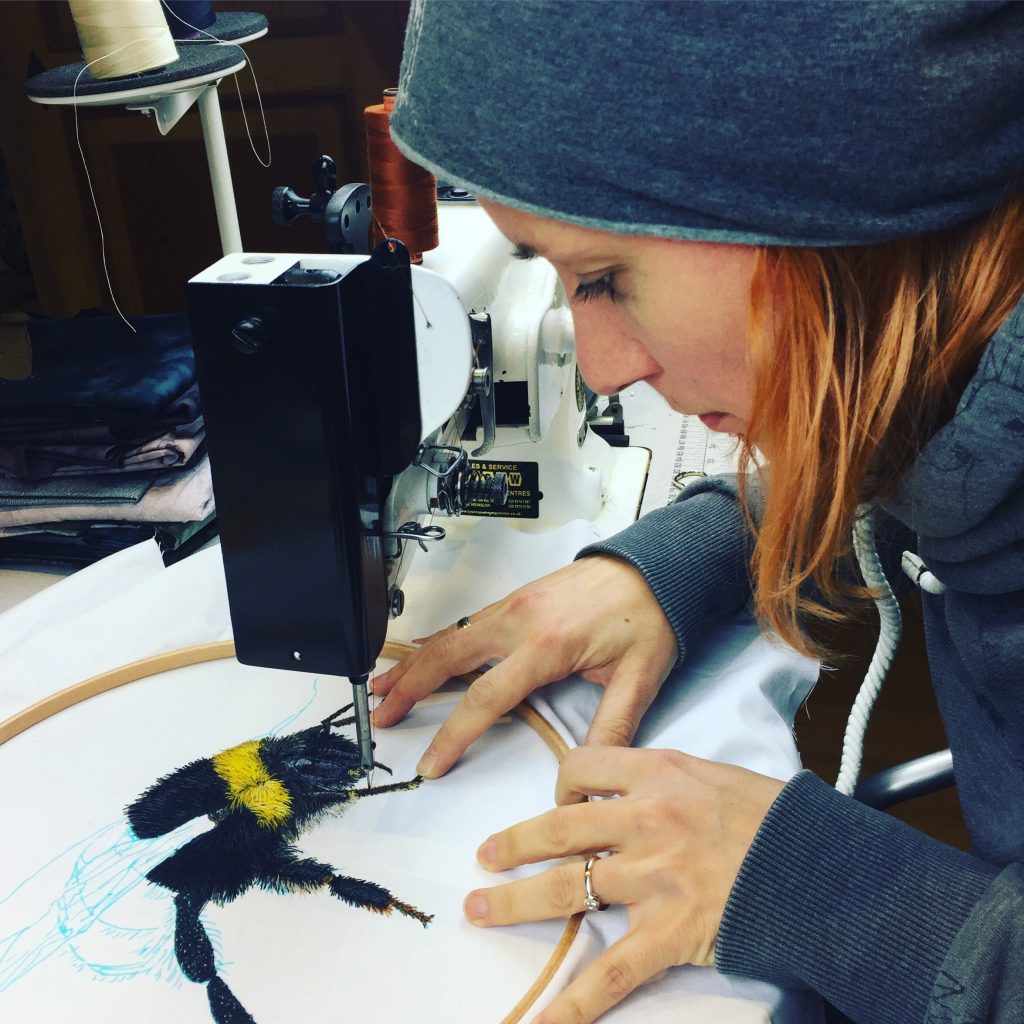Barbara Heller Tapestry Artist - BC, Canada
Explain how you personally have promoted tapestry both locally and internationally?
The most visible way I promote tapestry is by weaving in the corner window of my studio on Granville Island, an area of Vancouver that many tourists and locals visit daily. For 5 hours a day the studio is open to the public and I and my partners meet and educate people (and sell our work).
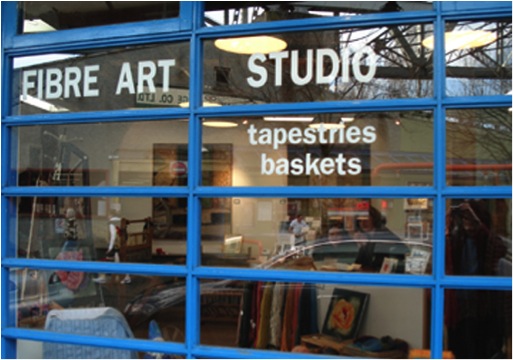
‘Fibre Art Studio’
After teaching myself tapestry in the 1970’s and weaving and exhibiting for a number of years, I ventured out to take a master class in California and to connect with other tapestry weavers at conferences and symposia. In 1992, I was one of five Canadians to be invited to an international event in Poland and was asked to give a slide lecture about Canadian tapestry. The contacts I made through finding artists in every province and soliciting slides of their work led to an informal newsletter and then to the Canadian Tapestry Network newsletter which is published three times a year.
At the Polish conference someone wondered aloud how we could meet again soon and I, not knowing what was in store for me, said I would put on an event in Vancouver the next year. That resulted in Making a Place for Tapestry, several exhibitions, and a book. I do believe that if you want something to happen, you should just plunge in and make it happen.
Also locally, I founded the British Columbia Society of Tapestry Artists (BCStars) a non-profit to support the art of tapestry through lectures and exhibits. Our first project was a large community tapestry woven at the main library in downtown Vancouver and then donated to the Aids Centre.
I have been a member of the [North] American Tapestry Alliance for many, many years and have served on their board and, more recently, as their Distance Learning (mentoring) chair. As tapestry is not a common vocation, the passionate weavers around the world have found each other and formed what my husband calls the ‘tapestry mafia’ – I can travel almost anywhere around the world and find another tapestry weaver to connect with.
Explain briefly the technique you use for your tapestries. Beginning with the cartoon to the final cut off?
For me, the image is always paramount and the method serves the image. I usually work from my own photos, often collaging images together to support the message and emotional impact I am looking for. I then project the images on the wall at a relatively small scale (say 18”x24”) and work out the basics, making many drawings. When I am satisfied, I have the drawing blown up to final size and re-draw to make it weavable. This is the cartoon that goes behind my loom. I know a computer can be used to do much of this but I think that drawing and re-drawing allows me time to know the cartoon intimately before I start to weave.
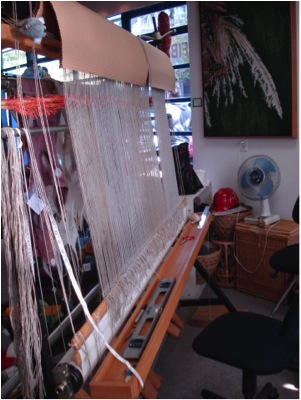
Loom Warped
I weave on a high-warp 6’ loom with linen warp at 8epi though I may weave areas at 4epi to use my hand spun yarns for texture. I hand-dye the majority of my weft yarns because colour is so important to me. I mark my cartoon with the values (light to dark) of the various areas but choose my colours from the wool, not by painting the cartoon beforehand. It can take months and months to weave a large tapestry and intuitively choosing colours keeps me interested and engaged. Thus, I often have to stop to dye a new colour. I believe in serendipity and the unusual solution.
Weaving a tapestry is like building a brick wall. You start at the bottom and weave decreasing shapes one area at a time until you reach the top. That is, if all goes smoothly – and it rarely does. I sometimes have to reweave an area after I progress up several inches as my original idea or colour choices do not work in context.
When the top hem is woven, the tapestry is cut from the loom and left to rest for a few days. Then there is still much finishing work to do and, as I regard my work as woven paintings, I also stretch and frame them.
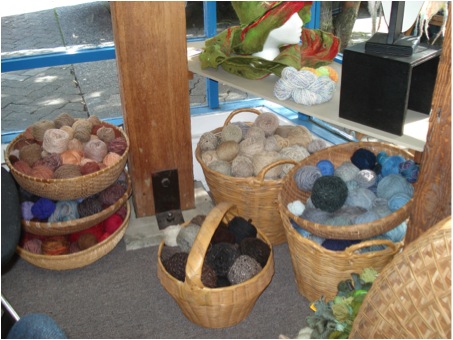
Yarn Baskets
Size, explain the size of your work and why?
Originally tapestries were mural art to warm cold castle walls or educate the public in church, like stained glass windows. I have done some very large commissions for public buildings but now only weave tapestries up to the 6’ my loom allows. That said, it is the image that is important and some need to be small (12”x12”) and some need to be mid-sized.
Expand on your comparisons with tapestry and computers within a historical perspective. Up/down – On/off – Punch cards
The ‘Future Reliquary’ Series deals with three apparently separate but, in my mind, connected histories: weaving, computing, and religion.

‘Future Reliquary’
Weaving is a binary system of up/down, just as computing is a binary system of on/off. The first computer was a jacquard loom complete with punch cards instructing the loom to raise or lower warp threads depending on the position of the holes in the cards. The most intricate and expensive brocades could be woven cheaper and faster by machine following a binary code. Weaving was now one step removed from the human hand. Today’s computers are merely fast jacquard looms programmed in binary code, thinking is now one step removed from the human mind.
Religion is not only a story of faith, it is a story of history and social values. In the middle ages, the sale of shards of the bones of saints and pieces of the True Cross became a large commercial enterprise. These holy relics were housed in beautifully sculpted metal reliquaries and displayed in churches to be worshipped as the concrete symbols of faith and history. I am particularly fascinated by the reliquaries that hold the arm bones of saints, shaped like a hand and arm, usually in gold and often encrusted with jewels.
Today, we are creating a new religion, worshipping the technology we have created. Some years ago, I bought a new computer and wanted to recycle the old one, not just throw it in the garbage. Recycling depots for e-waste were not yet in existence, so I took the computer apart to at least recycle the plastic shell. What treasures were revealed within! I took apart a keyboard. I took apart a radio, then a mobile phone, a CD player. I saved the innards, the future relics of the saints of the connected society.
These tapestries depict the future holy status of today’s e-junk in the context of the ancient fabrics that gave birth to the binary system. In these tapestries, one code of up/down (weaving) morphs into the other code of on/off (computing). The pattern of the mother board or silicon chip morphs into the pattern of a traditional ethnic textile – contemporary computer parts as the concrete symbols of the birth of a religion. And the slits in the woven arm as the receptacles connecting the computer tower to the outer world.
Ethnic textiles are still woven all over the world by hand. No machines intervene as the weavers record their personal stories, their faith, and their culture in the patterned cloth. Complex stories are told in simple binary form.
Discuss the importance of location in your work? (using ‘Habibi’)

‘Habibi’
Location is very important in my work. The right colours, time of day, part of the world – it must all work together to support the message, the subject of the tapestry.
‘Habibi’ came from photos taken on a trip to Egypt and was part of a projected series of works about children displaced by war (but I only wove two). This young toddler (apparently unaffected by the violence and poverty around him) gazes out at the world while the mother turns away. A gun rests casually against the doorpost and a colourful carriage passes by. What will this child’s future be? Will he rise out of the poverty of his home? Will he grow to be a soldier? Will he travel to a new life? An exotic locale gives us the distance to contemplate these questions, but they apply to everyone everywhere.
Can you discuss your statement, “My themes are becoming more demanding and as the news becomes more depressing, my tapestries are becoming more explicit.”
When I started weaving, my messages were more subtle, hidden within the beauty of the yarn and the images. But since the millennium, as I view the state of the world and become increasingly upset by what I see, my work is more confrontational – dead birds, land mines, plastic pollution, the degradation of the environment. I want to make people stop and think about what they are doing, and perhaps to seek a new way to live in harmony with each other and the earth.
Expand on your use of dead birds and their symbolism in your work?
I have incorporated dead birds in many of my tapestries as a personal icon representing senseless killing by both animals and mankind. The first dead birds that I wove were a series of requiems for the birds my cat was killing and not always eating. As a vegetarian and a pacifist, this carnage was difficult to deal with. As I wove this series, I listened to the radio – news of the first Gulf War on CNN and CBC. Images of dead bodies and of bombs dropped with the aid of remote sensing technology became mixed in my mind with images of dead birds viewed through the lens of a camera. As I sat at my loom weaving images of death, my purpose in weaving these tapestries grew from simple blessings for the souls of the birds to encompass my response to all ritual killing.
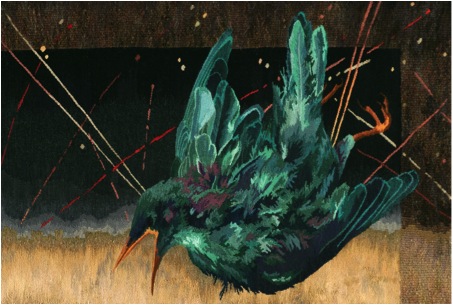
‘Ozymandias, detail’
I continue to use this image but the dead birds (or parts of birds) now stand for many things. It is a symbol that everyone seems to relate to and view through their own interpretations. For instance, in ‘Ozymandias’ some people feel the bird is an avenging angel while others have said it is coming to rescue the world. I try to work with universal symbols that reach people on many levels.
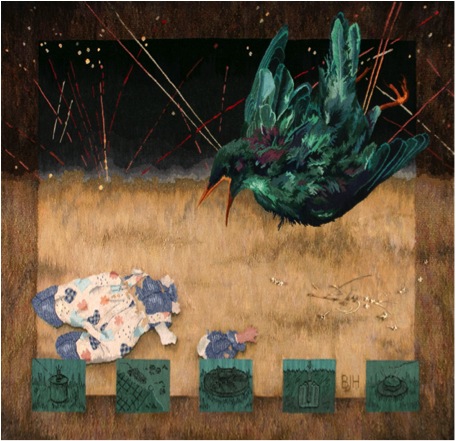
‘Ozymandias’
Can you explain how 9/11 has influenced your work?
I have woven one piece explicitly about 9/11, ‘Still Life…with Bird,’ though acts of terror are a continuing horror. In that tapestry, the skeleton of the world trade centre, the skeleton of a bird wing, and actual bones are all testaments to terrorism as a tactic of war. The orange sky evokes the aftermath of 9/11, the bones evoke museum displays. Bones are precious; they can be buried in a cairn or burned in a crematorium or buried in another sense in a dusty museum drawer. Think of the native tribes seeking to recover the bones of their ancestors. In future ages will archaeologists dig in what was once New York and wonder at what they find? The stories of bone fragments of truly minuscule size being used to trace the person they belonged to through DNA affected me deeply.
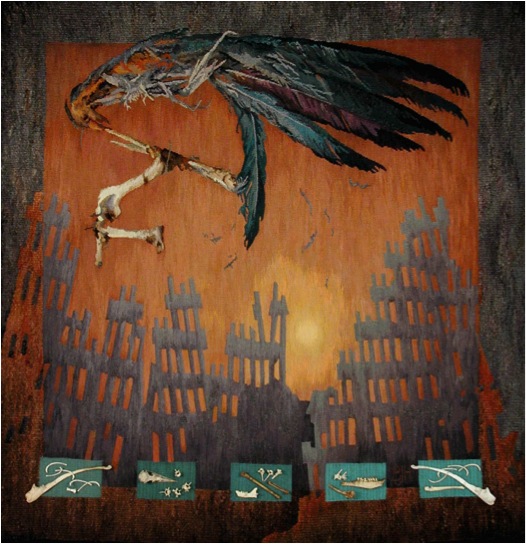
‘Still Life…with Bird’
You have many exhibitions at the Elliot Louis Gallery can you expand on this particular Gallery’s interest in tapestry?
This gallery has recently closed but still exists virtually: the website is still viable and the owner, Ted Lederer, sells online. I was thrilled to find a local commercial gallery owner who regarded tapestry as an art form and was willing to promote my work. He also exhibited the work of several other fibre artists.
Can you discuss your ‘Cover Up’ Series? How did you choose the 9 portraits in this series?
“We are locked into other people’s perceptions of who we are, he thought. We are none of us free to live our lives unseen.”
Timothy Findlay in “Pilgrim”
“A man in a uniform…or a man in a robe, for they are the same things, is not a man but a cipher, but a function, but a walking idea; his clothes walk and speak for him. And under cover, who knows who he is or what he does.”
A.S. Bayatt in “Babel Tower”
The ‘Cover-Up’ series is comprised of 9 portraits in which the bodies and faces of the people depicted are obscured by their costume. While each stares straight out of the tapestry at us, a sense of tension arises as we strive to make eye contact but cannot. In the absence of facial expression to reveal character, we search for other clues to personality and revert to stereotypes to assign identity.
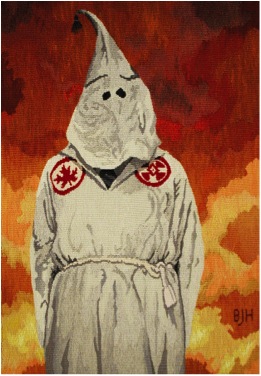
Canadian Klansman
I did quite a lot of research to find the images, wanting to depict men and women, ethnic and western individuals. I chose the ones that spoke to me most. Some are collaged, some are used with the permission of the photographer, and the surgeon and the bride are my own photos.
I have purposely made the body language of the figures belie the normal interpretation we put on their costumes to increase our level of discomfort. The ‘Canadian Klansman’ presents as an innocuous elfin businessman complete with paunch and old school tie. His hood even has a tassel.
The downtrodden ‘Afghani Woman’ whose chador covers her hands making her even more powerless, stares out in a strong, almost intimidating manner. Even though we cannot see her eyes, we are moved to lower our own.

Afghani Woman
The ‘French Foreign Legionnaires’ stand in fashion model poses. I wanted to make the viewer stop for a moment and open a dialogue with these covered-up individuals. If the stereotypes are not true, who are these people?
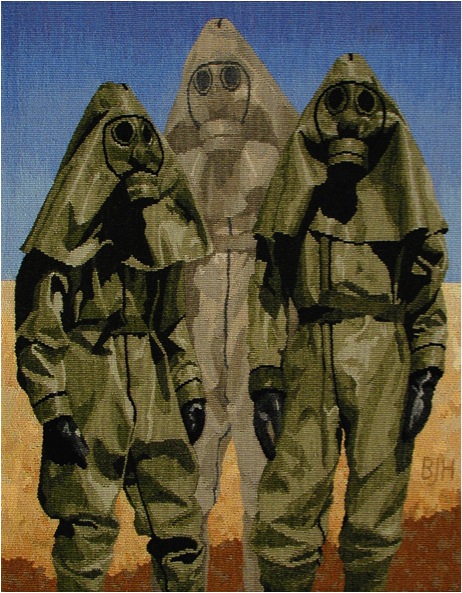
French Foreign Legionnaires
In times of terrorist attacks and racial profiling, can we afford to “judge a book by its cover”? Genetically programmed to make split second decisions as to whether an individual is friend or foe, I hope the viewers’ thwarted assumptions lead them to take a few more seconds to question their reactions.
Can you discuss background in your work, e.g. ‘Bedouin Woman’
In tapestry one weaves the background and the foreground at the same time. One is not superimposed on the other and so both have equal importance.

Bedouin Woman
In the ‘Cover Up’ series I tried to create backgrounds that would provide context for the figures and enhance the message. In ‘Bedouin Woman’ the background is woven in warm tropical colours in shapes reminiscent of palm trees; in ‘Canadian Klansman’ the background is fire – the world is ablaze; in ‘Afghani Woman’ she stands before a cold grey stone wall like a prison.
Discuss your passion with stone, stone walls and your tapestries?
I have always been drawn to stonewalls, especially ones made without dressing the stones or using cement – walls, often from ancient ruins, that could crumble and no one would ever know they had been there. Whenever we travelled I would photograph them. To me they were symbols of man living in harmony with his surroundings and I saw the spirit of the makers in them. This idea led to a series where I placed a transparent figure, often taken from old family photos, in front of a wall. And as I said above, weaving a tapestry is like building a stone wall so I can smile at the idea on a meta level as well.
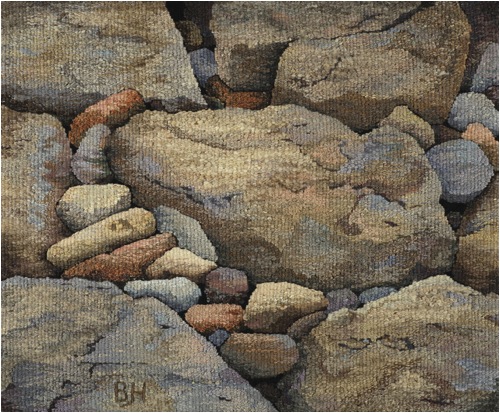
Stonewalls #20 Stonewall Blues/p>
On a more mundane level, I love their abstract nature. My hand-spun, hand-dyed yarns is perfectly suited to translate them into tapestry. Weaving stones gives me the opportunity to play with colour and texture and these tapestries are a wonderful break from more depressing subjects.
This spring, after working on three large works about the environment for a solo show, I wove two more stonewalls, bringing my total to twenty-two.
How important is poetry to the inspiration of your work?
Reading both prose and poetry often inspires a work or seems relevant to illustrate an idea. My husband writes poetry and there are several of his poems about my tapestries on my website. They give the tapestries another layer of meaning.
Discuss the work, ‘Shiva Dances’
‘Shiva Dances’ is based on Hubble telescope images of a distant nebula. Nebulae arise from black holes, the site of both the destruction of stars and their creation. Shiva is a Hindu God/Goddess often depicted dancing; she is goddess of both creation and destruction, as the two are inextricably intertwined and are constantly evolving one from the other (yin and yang).
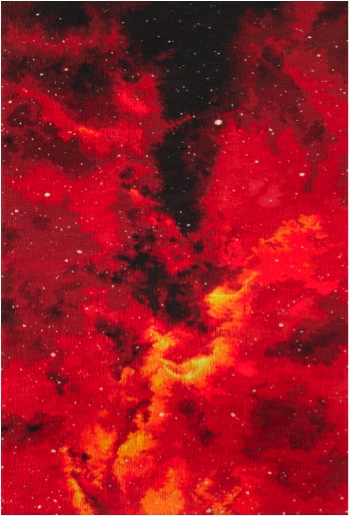
‘Shiva Dances’
These days, all we seem to read about is destruction. I feel life is a cycle and we need to find ways to turn this destruction into an opportunity of new creation, into a more harmonious way of life.
Tell us about the changes that have taken place in your work through three images?
All the Diamonds (1982) | The Last Resort (1992) | Detritus (2014)
I work in series: sometimes several tapestries in a row explore a theme, sometimes a theme recurs over and over again through the years (as in the Stonewall series). In a previous artistic incarnation I was a printmaker, but I became allergic to the chemicals and had to abandon the medium. Tapestry was another way to make images and explore ideas and my first tapestries were very graphic in nature. I wove landscapes (or seascapes) as in ‘All the Diamonds,’ a commission for a law office. Here three photos from three different perspectives were collaged together with imaginary elements to reinforce the beauty of sunlight on the ocean.
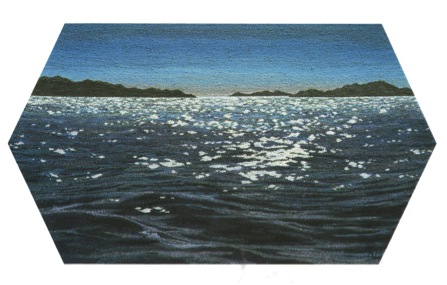
In subsequent years after the birth of my son, I was drawn to family history, family stories, whether true or misremembered, and old family photos. ‘The Last Resort’ is based on a photo my father took of his father when he was on a family vacation at the age of thirteen. I loved the gesture my grandfather made to ward off the budding amateur photographer and it became, for me, a symbol of the old order trying to ward off the new.
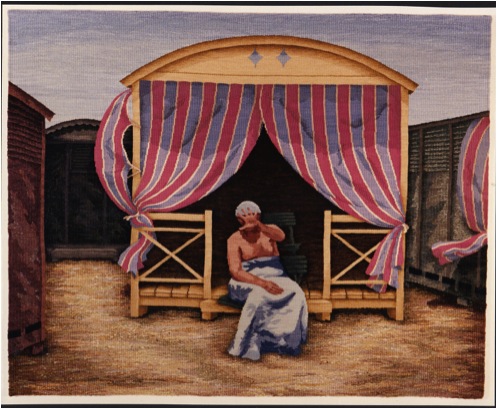
‘The Last Resort’
The title is a pun as is that of its partner piece, ‘Right of Passage’ which is also based on a photo taken by my father on the same day. In that tapestry, space has opened up between the bathing tents and my uncle looks at the viewer and at a new life.
My current work arose from my concern over what we are doing to our environment. ‘Detritus’ is based on photos I took four years ago as I walked along the beach beside Caesarea in Israel. I had visited there many years before and the crumblingstones of the ancient site had inspired a series of tapestries of transparent people against stone backgrounds. Now, though, I found the spirituality of the place desecrated by the bits of plastic intermingled with seashells and stones. Over the centuries, the site had seen invaders come and go over; they had built imposing edifices that could crumble into dust and be reabsorbed by nature, but today’s plastic will take millennia to disintegrate. I added a feather as my call to attention, a remnant of my dead birds, a reminder of the fragility of the ecosystem. We are all detritus thrown up on the beach.
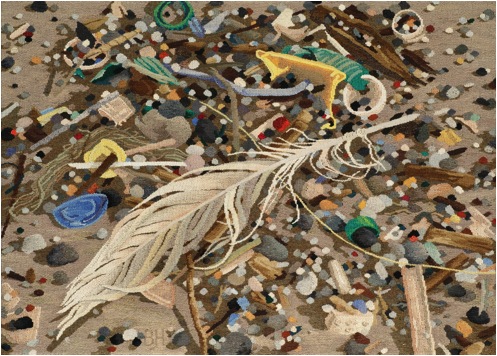
‘Detritus’
Explain how and why you use windows in your work?
I am drawn to doors and windows, the liminal area between two actual places or spiritual states. A door or window is a frame to isolate a figure or emphasize an act. It is an entry point for the viewer who cannot see the other side and can therefore let their imaginations roam. It is a link between worlds.
In ‘Sarah Rebecca,’ for example, a woman larger than lifesize is framed by the window of a shack found in the American Southwest. She is from another time and place judging by her clothing and hairstyle. How did she come to be there? Is she real or a ghost? She represents all the people dislocated from home by fear or hope. They have travelled through time and space to find a better life and their spirits linger on in their homes and in our memories.

‘Sarah Rebecca’
‘Dreams –Left Window’ and ‘Visions – Right Window’ are the outer panels of a triptych inspired by slides I took in the old Jewish quarter of Krakow, Poland. The tapestries deal with the power of memory to distort and to preserve and to keep a culture alive. The windows in the tapestries with their broken glass and crumbling wood are peopled by the spirits and stories of the generations who inhabited these now-disintegrating buildings. The woman on the left is from a photo by Roman Vishniak, the man on the right is my great-grandfather. They are all our ancestors who live in our memories.
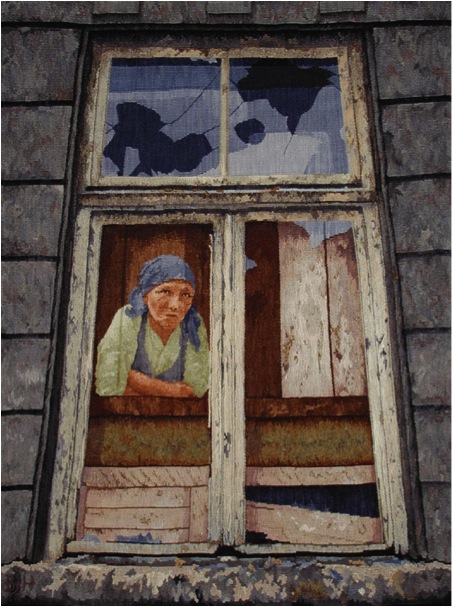
‘Dreams – Left Window’
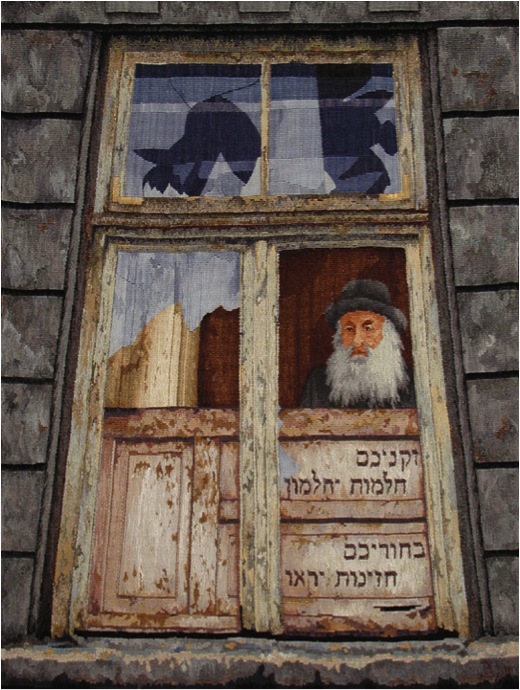
‘Visions – Right Window’
‘New Art of the Loom’ is group show curated by Dirk Holger, who arranged the tour and who is also publishing a book of the same name. He invited people to send him slides of large scale tapestries and chose work from that submitted. The weavers come from many countries and continents and only shipping costs have prohibited the exhibition from travelling outside North America.
‘Falling from Grace’ is a solo show curated by Barbara Duncan and includes all my tapestries dealing with bird imagery as well as a few others. She liked my work and invited me to show in her public gallery and the tapestries in the show were chosen by her. It is currently on exhibit at the Maple Ridge Art Gallery (until the end of July) and we hope to have it tour to other venues. There is a catalogue available with curatorial and critical essays and images of the work in the show.
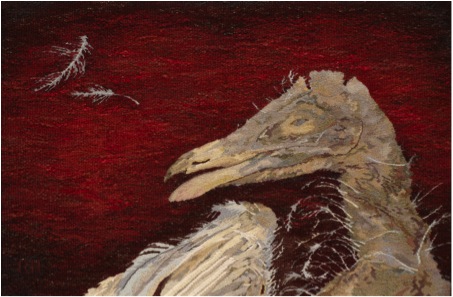
‘The Patriot’
Contact details.
bheller@telus.net
www.barbaraheller.ca
Barbara Heller, BC, Canada
Interview by Deborah Blakeley, July, 2014
Think a colleague or friend could benefit from this interview?
Knowledge is one of the biggest assets in any business. So why not forward this on to your friends and colleagues so they too can start taking advantage of the insightful information the artist has given?
Other artists you may be interested in:


